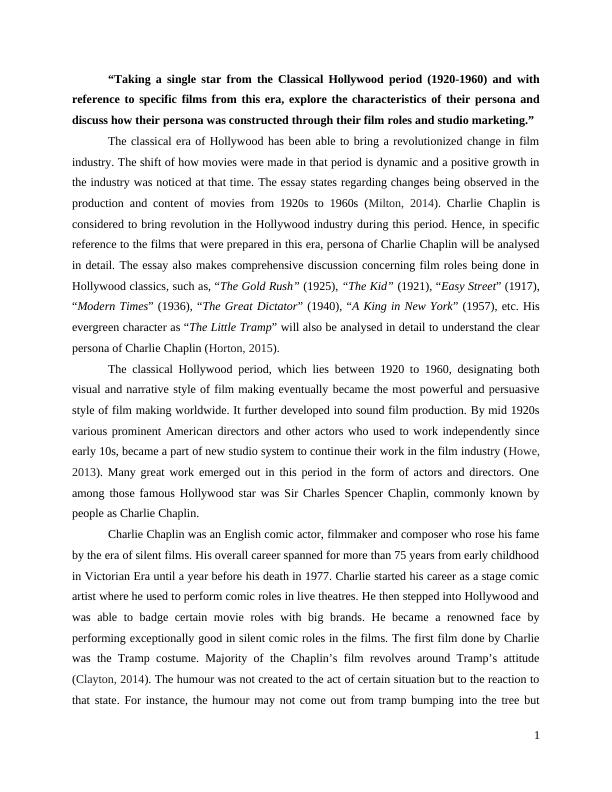Changes in Production and Content of Movies from 1920-1960 : Essay
8 Pages2727 Words105 Views
Added on 2020-07-23
Changes in Production and Content of Movies from 1920-1960 : Essay
Added on 2020-07-23
ShareRelated Documents
FILM HISTORY

“Taking a single star from the Classical Hollywood period (1920-1960) and withreference to specific films from this era, explore the characteristics of their persona anddiscuss how their persona was constructed through their film roles and studio marketing.”The classical era of Hollywood has been able to bring a revolutionized change in filmindustry. The shift of how movies were made in that period is dynamic and a positive growth inthe industry was noticed at that time. The essay states regarding changes being observed in theproduction and content of movies from 1920s to 1960s (Milton, 2014). Charlie Chaplin isconsidered to bring revolution in the Hollywood industry during this period. Hence, in specificreference to the films that were prepared in this era, persona of Charlie Chaplin will be analysedin detail. The essay also makes comprehensive discussion concerning film roles being done inHollywood classics, such as, “The Gold Rush” (1925), “The Kid” (1921), “Easy Street” (1917),“Modern Times” (1936), “The Great Dictator” (1940), “A King in New York” (1957), etc. Hisevergreen character as “The Little Tramp” will also be analysed in detail to understand the clearpersona of Charlie Chaplin (Horton, 2015). The classical Hollywood period, which lies between 1920 to 1960, designating bothvisual and narrative style of film making eventually became the most powerful and persuasivestyle of film making worldwide. It further developed into sound film production. By mid 1920svarious prominent American directors and other actors who used to work independently sinceearly 10s, became a part of new studio system to continue their work in the film industry (Howe,2013). Many great work emerged out in this period in the form of actors and directors. Oneamong those famous Hollywood star was Sir Charles Spencer Chaplin, commonly known bypeople as Charlie Chaplin. Charlie Chaplin was an English comic actor, filmmaker and composer who rose his fameby the era of silent films. His overall career spanned for more than 75 years from early childhoodin Victorian Era until a year before his death in 1977. Charlie started his career as a stage comicartist where he used to perform comic roles in live theatres. He then stepped into Hollywood andwas able to badge certain movie roles with big brands. He became a renowned face byperforming exceptionally good in silent comic roles in the films. The first film done by Charliewas the Tramp costume. Majority of the Chaplin’s film revolves around Tramp’s attitude(Clayton, 2014). The humour was not created to the act of certain situation but to the reaction tothat state. For instance, the humour may not come out from tramp bumping into the tree but1

lifting his hat out of apology. Dan Kamin has defined his comedy as quirky mannerism. His on-camera tricks were the common features being found in all of his movies. Charlie’s work isconsidered as a core combination of tears and laughter. The film career for Charlie started in 1914 where he represented himself in a forgettablecharacter in the movie “Make a Living”. In order to differentiate himself from the crowd, helanded himself to a single identifiable character “The Little Tramp”. The character was idealisedas a little sweet man with a bowler hat, cane and moustache became the iconic figure of silent eraof comedy. The audience was introduced to this character through the movie “Kid Auto Races atVenice” in 1914 (Busigny and et.al., 2015). He was able to constantly create engaging films till1930s. Then he switched his genre to critically acclaimed films as well. Apart from comic moves, Charlie Chaplin was also able to do certain tragic scenes whilecreating another film, called “The Gold Rush” in 1925. The movie was inspired by the fate ofDonner Party. Certain controversial issues of the society were also touched by the him in moviessuch as, illegitimacy in “The Kid” (1921), drug use in “Easy Street” (1917) and immigration in“The immigrant” (1917). He was also able to incorporate political message through his films,which includes, “Modern Times” (1936) which depicted the miserable conditions of factoryworkers. “The Great Dictator” (1940) paraded the life of Adolf Hitler and Benito Mussolini.Other movie of Charlie Chaplin, called “Monsieur Verdoux” focussed on criticising war andcapitalism. “A King in New York” (1957) discussed the life incidences of McCarthyism(Shumway, 2015). There are various movies of Charlie Chaplin which incorporated autobiographicalelements. He was able to play himself every time as he faced miserable youth and even hischildhood days. The character being played in his movie “The Kid” was the representation ofchildhood trauma which he faced when he was send to orphanage as a child. Other film that hedid, named “Limelight” (1952) was the reflection of life of his parents. Certain researchersargued that the reflection of her roles was displayed in problematic relationship he faced due tohis mother getting mentally ill (Marazzato and Sparavigna, 2014). Common structure that is usually followed in the films of Charlie Chaplin looks like thesketches being tied together. Rather than having a strong tight knitted and unified storyline, it is atheme and setting of roles. These films are simple, relaxing and economic. His acting skills areconsidered as pioneer and his representation of comic is measured as one of the most important2

End of preview
Want to access all the pages? Upload your documents or become a member.
Related Documents
Charlie Chaplin and the History of Silent Filmslg...
|4
|996
|453
Developments in The Communication Assignmentlg...
|8
|2828
|106
